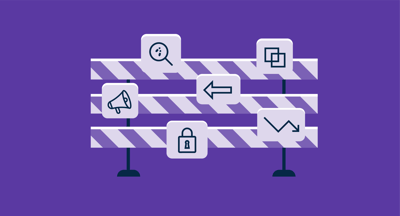
 Say goodbye to wasted SaaS spend
Say goodbye to wasted SaaS spend
Request a G2 Track demo today to learn more about what a SaaS system of record can do for your company.
No matter the size of a company, having visibility into SaaS applications within its tech stack is a top priority.
This visibility becomes almost impossible if data regarding software renewals, contract owners, and which applications are actually being used lives inside of a spreadsheet that no one is in charge of updating.
If you’re constantly running into issues that stem from shadow IT, missed contract renewals, redundant applications, or going over budget, then it’s time your company utilized a SaaS system of record.
A SaaS system of record like G2 Track can be the solution your company needs to eliminate wasted SaaS spending, eliminate unused applications, and never miss a contract renewal, all while putting data regarding your tech stack in one easy-to-read dashboard.
Whether you’re in IT, finance, marketing, HR, or any other team, here are six ways you can pitch a SaaS management tool to your CEO so you can solve these problems sooner rather than later.
The problem:
Within a software contract are licenses, otherwise known as seats, that an internal employee can assign out to other team members for them to use.
Typically, it’s easy to reassign a SaaS license, meaning someone switches it from one employee who no longer is using it or logging into the application, to someone who needs it and will use it daily.
But when your team is consistently reassigning SaaS licenses, and switching them from one employee to another, it can be a sign that the SaaS application licenses, or seats, aren’t the right size in relation to the needs of your organization. Or too many seats can indicate your business is spending too much money and the contract needs to be reevaluated before renewing.
Having too many or not enough licenses will let an organization know a contract isn’t as accurate as it should be. To prevent over or under estimating how many seats you’ll need, the right SaaS management tool or system of record will let you know the correct number of seats you should be purchasing for each application in real time, so you can make smarter decisions moving forward.
The pitch:
When this is something you’re running into at your company, here’s how you can pitch a SaaS system of record, like G2 Track, to your CEO.
“I’ve noticed that we’ve reallocated seats to SOFTWARE X five times already this month, bringing the total to 20 for the quarter. If we had a SaaS management tool that I could use to better visualize how many employers are actually using SOFTWARE X, I could apply this data when renegotiating our contract when it’s set to renew next quarter. If we keep this information in a spreadsheet like it is now, chances are it’ll get lost and we’ll end up wasting money on these seats.”
The problem:
It’s not uncommon for a marketing team to use Asana for project management, but the sales team at your company is using Trello. Or for your organization to pay for more than one video conferencing software. Similarly, employees could be storing their documents in both Google Drive and Dropbox.
It’s easy to think all teams are synced and using the same software solution, but most businesses have redundant SaaS applications within their tech stack. Not only does this hinder communication and potentially block workflows, but it could be using unnecessary funds within a budget.
A SaaS management tool like G2 Track identifies every instance of redundancy so your business can improve how teams work together, save money, and show opportunities to negotiate license agreements that feature prices and terms that are better aligned with their exact needs.
of software spend is on products with similar or overlapping functionality.
The pitch:
If you’re finding redundant SaaS applications that do the same thing or have similar features within your company’s tech stack, you could be throwing money out the window. Here’s how you can pitch using a SaaS system of record like G2 Track to ensure this no longer happens.
“I’ve noticed that our marketing team uses SOFTWARE X for project management but the sales team uses SOFTWARE Y. I have a feeling this has been going on for a while, and if we were to implement a SaaS system of record, I could have caught this months ago. I bet this isn’t the only situation where different departments within our company are using redundant SaaS apps, and if I had a SaaS management tool that alerted us to these redundancies we could eliminate them and start saving money.”
Rachael Tauber
Principal Enterprise Architect, AppDynamics
The problem:
Typically, knowing what’s going on regarding a company’s SaaS spend and staying on budget is the main reason why organizations turn to SaaS management tools like G2 Track.
Many times, a CEO or CFO will ask the question, “How much do we spend on all of our SaaS applications?” only to be told, “I’m not sure because we don’t have a SaaS system of record in place.”
Without this data and containing these costs upfront, organizations could be doing damage to their long-term and short-term financial goals.
The pitch:
If you’d had an exchange like this before with your CEO or CFO, it’s time you made the pitch for a SaaS system of record.
“I know previously you asked how much we spend on all of our SaaS applications and I didn’t have a clear answer. If we were to implement a SaaS system of record instead of keeping all of these details in a spreadsheet, we could pull up this data in just a few clicks so we can have a better idea of exactly how much we’re spending on these tools and if we’re going over budget.”
You can also add that not only will your company have a clear answer to that particular question, a SaaS management tool like G2 Track also provides insights into:
The problem:
Nothing results in unplanned SaaS spending faster than an unexpected or a missed SaaS renewal. While sometimes an automatic software renewal can be convenient, it can also be costly and problematic when it renews without the right ownership or utilization.
If a software renews and employees don’t find it to be critical to their daily work, don’t enjoy using it, or it’s simply not being used enough to justify its price, the fact that the notification period to cut ties with the vendor was missed can mean being locked into paying for the tool for another year at least.
The pitch:
If your company is consistently missing SaaS renewals because the notification period goes missed, here’s how you can pitch a SaaS management tool to be sure this doesn’t happen in the future.
“It looks like one of our contracts automatically renewed since we missed the notification period. While this tool fits our current needs, there’s probably a better option out there. If we were to invest in a SaaS management tool, we’d always have a clear picture of exactly when a contract is set to renew, the time period the vendor requires for cancellation, and who the internal owner of the contract is. Since this data would be moved from our spreadsheet to an easy-to-read dashboard, we would be sure that the contracts that renew are the ones we actually want to renew.”
Matt L.
G2 Track Review
The problem:
Any systems and software that are being used and managed without the knowledge or approval from IT leadership or stakeholders at your organization are referred to as shadow IT.
This can occur as long as an employee has a credit card, a browser, and a login, making it easy to purchase a low-cost subscription license right under the nose of the IT department.
While at first this may not seem like an issue, having too many instances of shadow IT can lead to security risks, like a data breach, as well as internal challenges like inefficient collaboration and compliance concerns. Perhaps most importantly, shadow IT makes it practically impossible for your business to track IT spending and manage SaaS renewals.
The pitch:
If shadow IT is running wild at your organization, it’s time to put a stop to it before something as detrimental as a data breach occurs.
“I’ve been monitoring our company’s network and I’ve noticed a large number of applications being used that haven’t been approved by our IT department. It’s in our company's best interest to deploy a SaaS management tool so I can better uncover every app and tool that uses employee and company data, as well as flag apps that have yet to be approved. This could save us from a data breach in the future, while also making sure we comply with all compliance standards.“
Did you know? Products that don’t have a clear owner, contract, or approval make up between 10-15% of a company’s tech stack. Check out more shadow IT statistics.
The problem:
How many applications within your company’s tech stack are being logged into and used daily? Of these applications, how many do employees actually like using?
Without access to user sentiment data by sending out pulse surveys asking for direct feedback, companies will remain in the dark.
The pitch:
“You know that fancy, feature-heavy, expensive SaaS tool we purchased six months ago? I recently found out that many employees aren’t even using it, and those who do aren’t finding it critical to their daily work or even enjoy using it.
"I have a feeling this isn’t the only SaaS application within our tech stack that isn’t being used like we thought it was. As our company grows, it’s important that we know how our employees feel about the tools being used and if these tools are critical to their daily workflow. Using a SaaS management tool can provide us with these answers.”
Pitching any sort of new software to your CEO or CFO can be nerve-wracking. With these six pitches, you can effortlessly explain why G2 Track is the solution your business needs to get its SaaS in gear.
At the end of your pitch, don’t forget to mention that you can get even more insights into problems G2 Track can solve by requesting a free demo.
Mara Calvello is a Content and Communications Manager at G2. She received her Bachelor of Arts degree from Elmhurst College (now Elmhurst University). Mara writes content highlighting G2 newsroom events and customer marketing case studies, while also focusing on social media and communications for G2. She previously wrote content to support our G2 Tea newsletter, as well as categories on artificial intelligence, natural language understanding (NLU), AI code generation, synthetic data, and more. In her spare time, she's out exploring with her rescue dog Zeke or enjoying a good book.
 Say goodbye to wasted SaaS spend
Say goodbye to wasted SaaS spend
Request a G2 Track demo today to learn more about what a SaaS system of record can do for your company.
Having a place for everything is crucial in every aspect of our lives.
 by Mara Calvello
by Mara Calvello
When it comes to your SaaS tech stack, there’s a lot to keep track of.
 by Mara Calvello
by Mara Calvello
Think about how many SaaS applications your business uses.
 by Mara Calvello
by Mara Calvello
Having a place for everything is crucial in every aspect of our lives.
 by Mara Calvello
by Mara Calvello
When it comes to your SaaS tech stack, there’s a lot to keep track of.
 by Mara Calvello
by Mara Calvello


